Analysis of MYOB's Financial Performance: HI5020 Corporate Accounting
VerifiedAdded on 2023/06/11
|11
|2453
|349
Report
AI Summary
This report provides a detailed analysis of MYOB's financial statements from FY2015 to FY2017. It includes a comparative analysis of the cash flow statement, examining operating, investing, and financing activities, highlighting trends in cash receipts, payments to suppliers, and investments in product development and acquisitions. The report also analyzes MYOB's other comprehensive income (OCI), focusing on foreign currency translation reserves. Furthermore, the report computes and reconciles the corporate income tax paid by MYOB, identifying differences between the expected tax based on net income and the actual tax paid, and explaining the variations based on factors like entertainment expenses, research and development tax exclusions, and adjustments for overseas tax and depreciation. This analysis provides a comprehensive overview of MYOB's financial performance and tax obligations during the specified period. Desklib provides similar solved assignments for students.
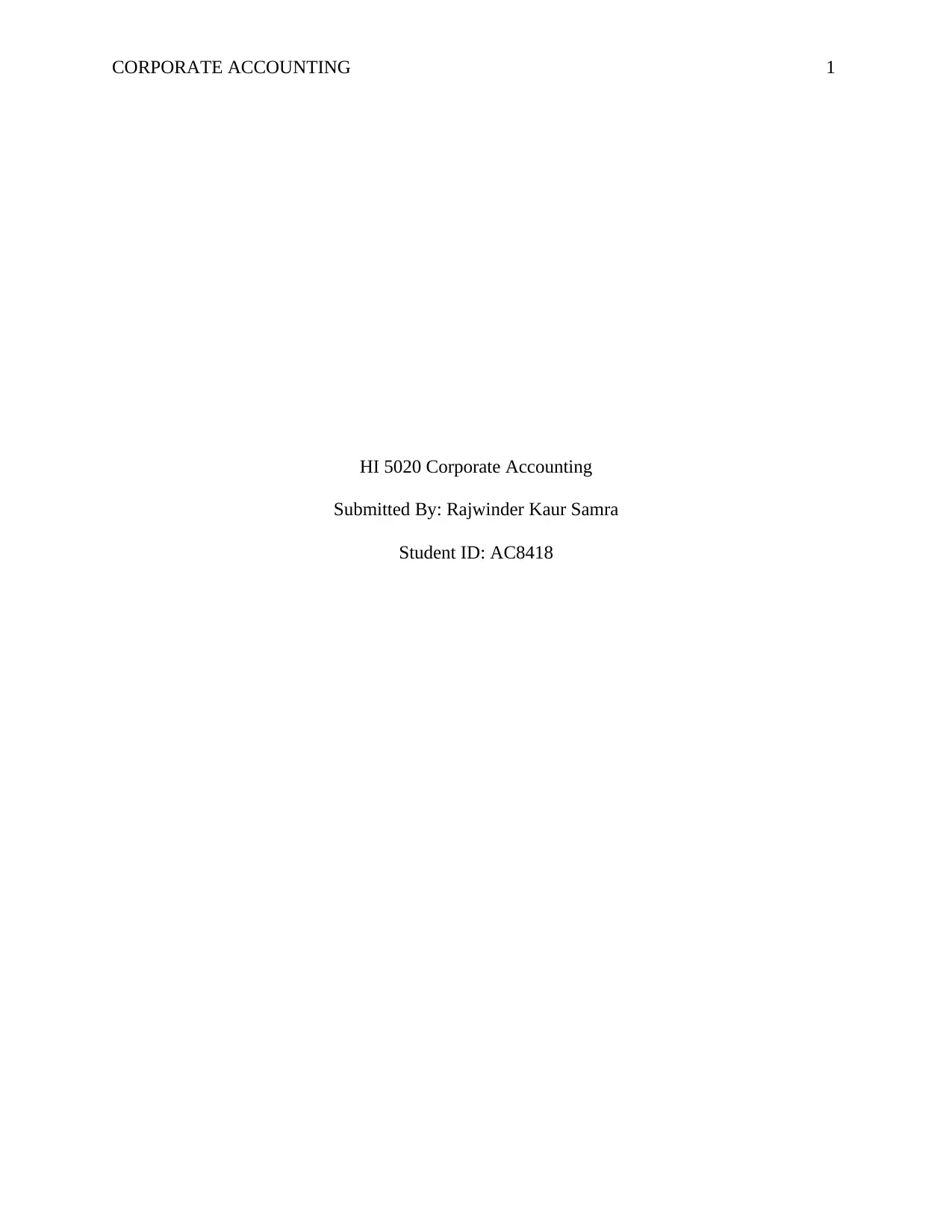
CORPORATE ACCOUNTING 1
HI 5020 Corporate Accounting
Submitted By: Rajwinder Kaur Samra
Student ID: AC8418
HI 5020 Corporate Accounting
Submitted By: Rajwinder Kaur Samra
Student ID: AC8418
Paraphrase This Document
Need a fresh take? Get an instant paraphrase of this document with our AI Paraphraser
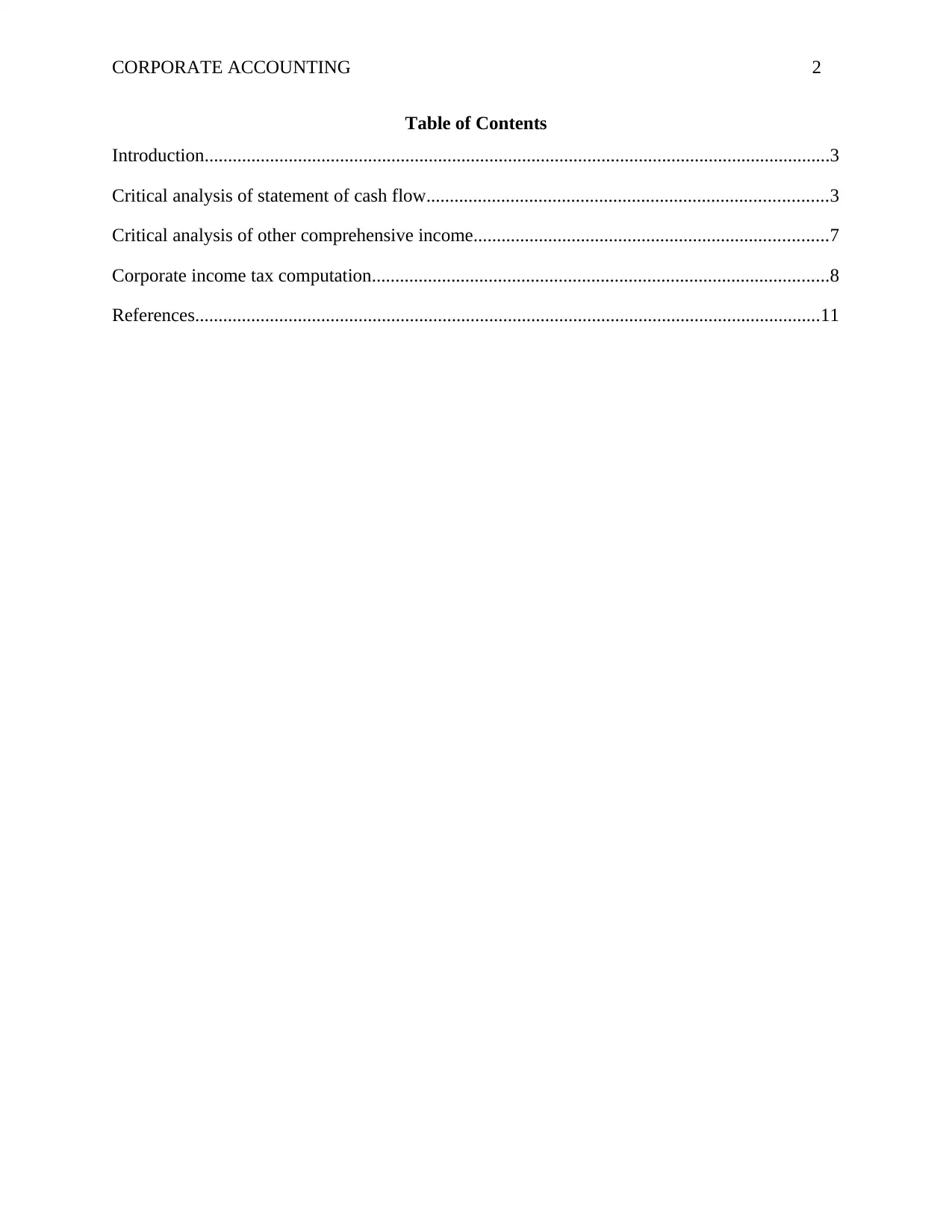
CORPORATE ACCOUNTING 2
Table of Contents
Introduction......................................................................................................................................3
Critical analysis of statement of cash flow......................................................................................3
Critical analysis of other comprehensive income............................................................................7
Corporate income tax computation..................................................................................................8
References......................................................................................................................................11
Table of Contents
Introduction......................................................................................................................................3
Critical analysis of statement of cash flow......................................................................................3
Critical analysis of other comprehensive income............................................................................7
Corporate income tax computation..................................................................................................8
References......................................................................................................................................11
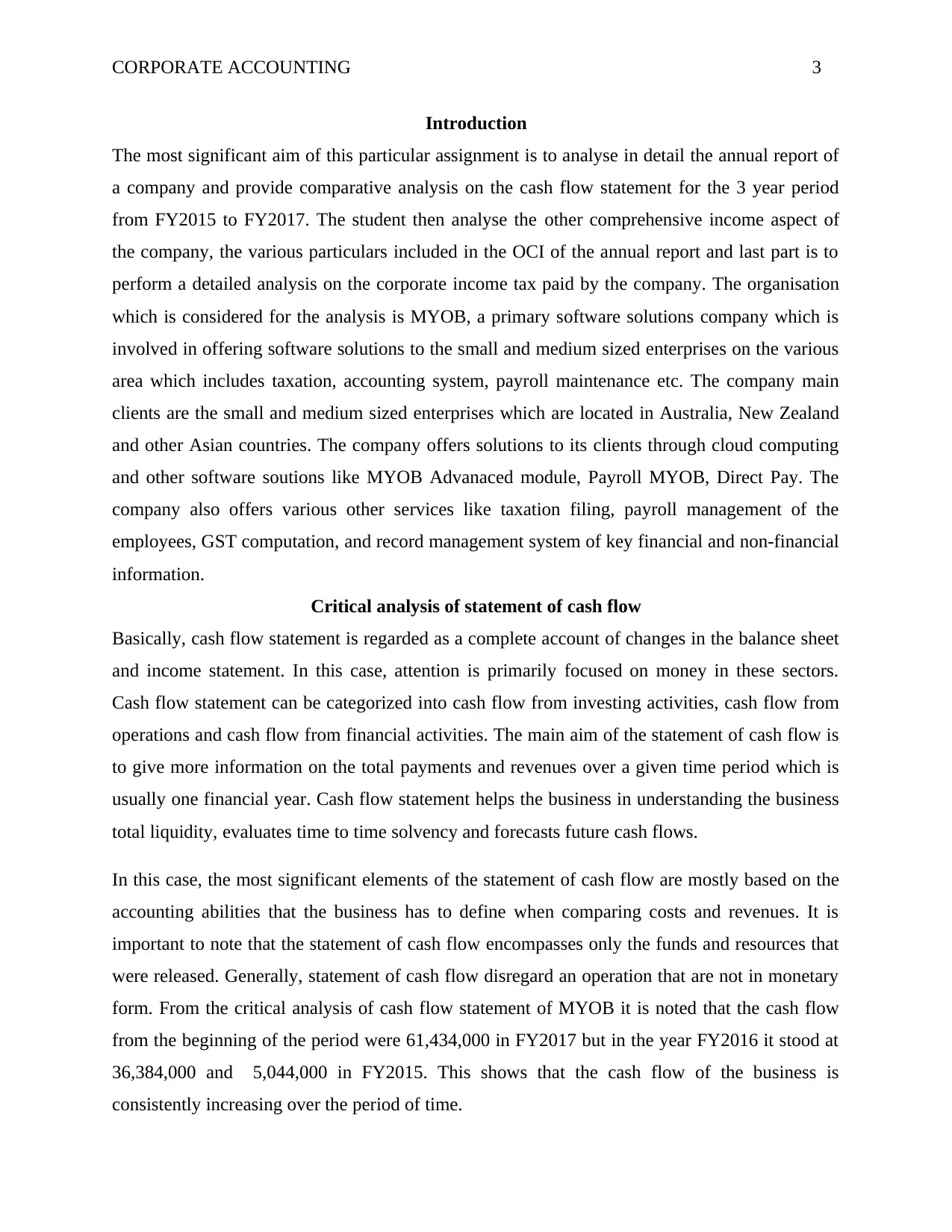
CORPORATE ACCOUNTING 3
Introduction
The most significant aim of this particular assignment is to analyse in detail the annual report of
a company and provide comparative analysis on the cash flow statement for the 3 year period
from FY2015 to FY2017. The student then analyse the other comprehensive income aspect of
the company, the various particulars included in the OCI of the annual report and last part is to
perform a detailed analysis on the corporate income tax paid by the company. The organisation
which is considered for the analysis is MYOB, a primary software solutions company which is
involved in offering software solutions to the small and medium sized enterprises on the various
area which includes taxation, accounting system, payroll maintenance etc. The company main
clients are the small and medium sized enterprises which are located in Australia, New Zealand
and other Asian countries. The company offers solutions to its clients through cloud computing
and other software soutions like MYOB Advanaced module, Payroll MYOB, Direct Pay. The
company also offers various other services like taxation filing, payroll management of the
employees, GST computation, and record management system of key financial and non-financial
information.
Critical analysis of statement of cash flow
Basically, cash flow statement is regarded as a complete account of changes in the balance sheet
and income statement. In this case, attention is primarily focused on money in these sectors.
Cash flow statement can be categorized into cash flow from investing activities, cash flow from
operations and cash flow from financial activities. The main aim of the statement of cash flow is
to give more information on the total payments and revenues over a given time period which is
usually one financial year. Cash flow statement helps the business in understanding the business
total liquidity, evaluates time to time solvency and forecasts future cash flows.
In this case, the most significant elements of the statement of cash flow are mostly based on the
accounting abilities that the business has to define when comparing costs and revenues. It is
important to note that the statement of cash flow encompasses only the funds and resources that
were released. Generally, statement of cash flow disregard an operation that are not in monetary
form. From the critical analysis of cash flow statement of MYOB it is noted that the cash flow
from the beginning of the period were 61,434,000 in FY2017 but in the year FY2016 it stood at
36,384,000 and 5,044,000 in FY2015. This shows that the cash flow of the business is
consistently increasing over the period of time.
Introduction
The most significant aim of this particular assignment is to analyse in detail the annual report of
a company and provide comparative analysis on the cash flow statement for the 3 year period
from FY2015 to FY2017. The student then analyse the other comprehensive income aspect of
the company, the various particulars included in the OCI of the annual report and last part is to
perform a detailed analysis on the corporate income tax paid by the company. The organisation
which is considered for the analysis is MYOB, a primary software solutions company which is
involved in offering software solutions to the small and medium sized enterprises on the various
area which includes taxation, accounting system, payroll maintenance etc. The company main
clients are the small and medium sized enterprises which are located in Australia, New Zealand
and other Asian countries. The company offers solutions to its clients through cloud computing
and other software soutions like MYOB Advanaced module, Payroll MYOB, Direct Pay. The
company also offers various other services like taxation filing, payroll management of the
employees, GST computation, and record management system of key financial and non-financial
information.
Critical analysis of statement of cash flow
Basically, cash flow statement is regarded as a complete account of changes in the balance sheet
and income statement. In this case, attention is primarily focused on money in these sectors.
Cash flow statement can be categorized into cash flow from investing activities, cash flow from
operations and cash flow from financial activities. The main aim of the statement of cash flow is
to give more information on the total payments and revenues over a given time period which is
usually one financial year. Cash flow statement helps the business in understanding the business
total liquidity, evaluates time to time solvency and forecasts future cash flows.
In this case, the most significant elements of the statement of cash flow are mostly based on the
accounting abilities that the business has to define when comparing costs and revenues. It is
important to note that the statement of cash flow encompasses only the funds and resources that
were released. Generally, statement of cash flow disregard an operation that are not in monetary
form. From the critical analysis of cash flow statement of MYOB it is noted that the cash flow
from the beginning of the period were 61,434,000 in FY2017 but in the year FY2016 it stood at
36,384,000 and 5,044,000 in FY2015. This shows that the cash flow of the business is
consistently increasing over the period of time.
⊘ This is a preview!⊘
Do you want full access?
Subscribe today to unlock all pages.

Trusted by 1+ million students worldwide
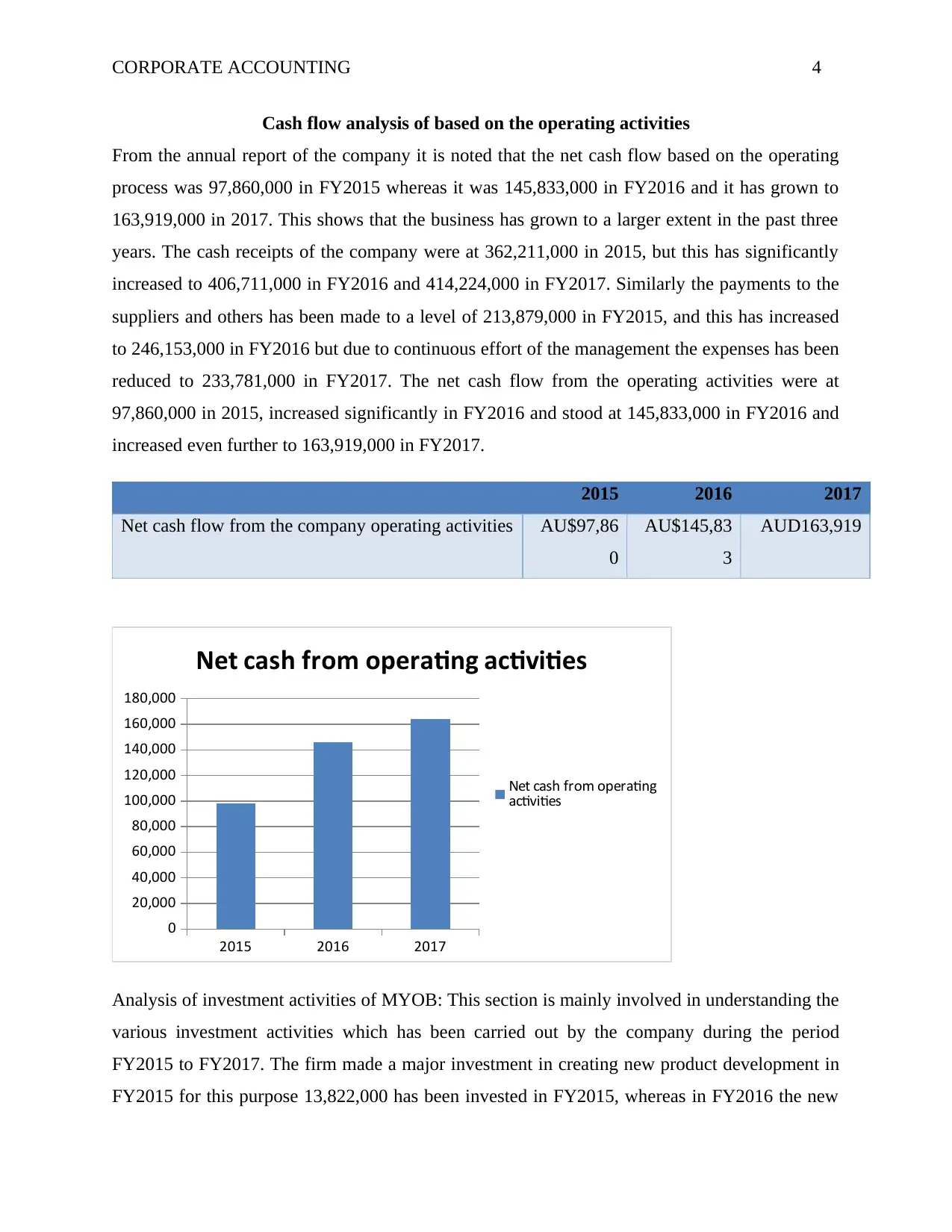
CORPORATE ACCOUNTING 4
Cash flow analysis of based on the operating activities
From the annual report of the company it is noted that the net cash flow based on the operating
process was 97,860,000 in FY2015 whereas it was 145,833,000 in FY2016 and it has grown to
163,919,000 in 2017. This shows that the business has grown to a larger extent in the past three
years. The cash receipts of the company were at 362,211,000 in 2015, but this has significantly
increased to 406,711,000 in FY2016 and 414,224,000 in FY2017. Similarly the payments to the
suppliers and others has been made to a level of 213,879,000 in FY2015, and this has increased
to 246,153,000 in FY2016 but due to continuous effort of the management the expenses has been
reduced to 233,781,000 in FY2017. The net cash flow from the operating activities were at
97,860,000 in 2015, increased significantly in FY2016 and stood at 145,833,000 in FY2016 and
increased even further to 163,919,000 in FY2017.
2015 2016 2017
Net cash flow from the company operating activities AU$97,86
0
AU$145,83
3
AUD163,919
2015 2016 2017
0
20,000
40,000
60,000
80,000
100,000
120,000
140,000
160,000
180,000
Net cash from operating activities
Net cash from operating
activities
Analysis of investment activities of MYOB: This section is mainly involved in understanding the
various investment activities which has been carried out by the company during the period
FY2015 to FY2017. The firm made a major investment in creating new product development in
FY2015 for this purpose 13,822,000 has been invested in FY2015, whereas in FY2016 the new
Cash flow analysis of based on the operating activities
From the annual report of the company it is noted that the net cash flow based on the operating
process was 97,860,000 in FY2015 whereas it was 145,833,000 in FY2016 and it has grown to
163,919,000 in 2017. This shows that the business has grown to a larger extent in the past three
years. The cash receipts of the company were at 362,211,000 in 2015, but this has significantly
increased to 406,711,000 in FY2016 and 414,224,000 in FY2017. Similarly the payments to the
suppliers and others has been made to a level of 213,879,000 in FY2015, and this has increased
to 246,153,000 in FY2016 but due to continuous effort of the management the expenses has been
reduced to 233,781,000 in FY2017. The net cash flow from the operating activities were at
97,860,000 in 2015, increased significantly in FY2016 and stood at 145,833,000 in FY2016 and
increased even further to 163,919,000 in FY2017.
2015 2016 2017
Net cash flow from the company operating activities AU$97,86
0
AU$145,83
3
AUD163,919
2015 2016 2017
0
20,000
40,000
60,000
80,000
100,000
120,000
140,000
160,000
180,000
Net cash from operating activities
Net cash from operating
activities
Analysis of investment activities of MYOB: This section is mainly involved in understanding the
various investment activities which has been carried out by the company during the period
FY2015 to FY2017. The firm made a major investment in creating new product development in
FY2015 for this purpose 13,822,000 has been invested in FY2015, whereas in FY2016 the new
Paraphrase This Document
Need a fresh take? Get an instant paraphrase of this document with our AI Paraphraser
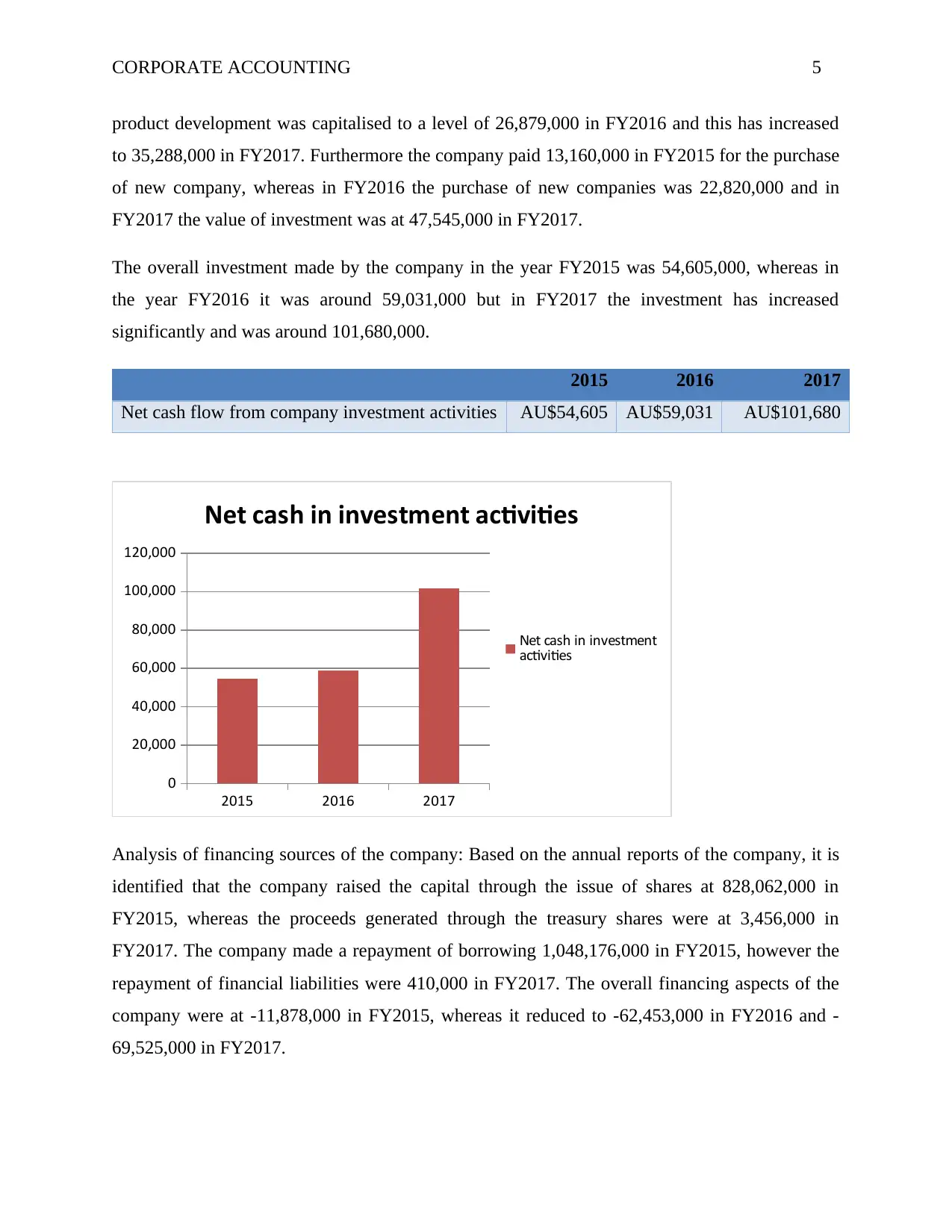
CORPORATE ACCOUNTING 5
product development was capitalised to a level of 26,879,000 in FY2016 and this has increased
to 35,288,000 in FY2017. Furthermore the company paid 13,160,000 in FY2015 for the purchase
of new company, whereas in FY2016 the purchase of new companies was 22,820,000 and in
FY2017 the value of investment was at 47,545,000 in FY2017.
The overall investment made by the company in the year FY2015 was 54,605,000, whereas in
the year FY2016 it was around 59,031,000 but in FY2017 the investment has increased
significantly and was around 101,680,000.
2015 2016 2017
Net cash flow from company investment activities AU$54,605 AU$59,031 AU$101,680
2015 2016 2017
0
20,000
40,000
60,000
80,000
100,000
120,000
Net cash in investment activities
Net cash in investment
activities
Analysis of financing sources of the company: Based on the annual reports of the company, it is
identified that the company raised the capital through the issue of shares at 828,062,000 in
FY2015, whereas the proceeds generated through the treasury shares were at 3,456,000 in
FY2017. The company made a repayment of borrowing 1,048,176,000 in FY2015, however the
repayment of financial liabilities were 410,000 in FY2017. The overall financing aspects of the
company were at -11,878,000 in FY2015, whereas it reduced to -62,453,000 in FY2016 and -
69,525,000 in FY2017.
product development was capitalised to a level of 26,879,000 in FY2016 and this has increased
to 35,288,000 in FY2017. Furthermore the company paid 13,160,000 in FY2015 for the purchase
of new company, whereas in FY2016 the purchase of new companies was 22,820,000 and in
FY2017 the value of investment was at 47,545,000 in FY2017.
The overall investment made by the company in the year FY2015 was 54,605,000, whereas in
the year FY2016 it was around 59,031,000 but in FY2017 the investment has increased
significantly and was around 101,680,000.
2015 2016 2017
Net cash flow from company investment activities AU$54,605 AU$59,031 AU$101,680
2015 2016 2017
0
20,000
40,000
60,000
80,000
100,000
120,000
Net cash in investment activities
Net cash in investment
activities
Analysis of financing sources of the company: Based on the annual reports of the company, it is
identified that the company raised the capital through the issue of shares at 828,062,000 in
FY2015, whereas the proceeds generated through the treasury shares were at 3,456,000 in
FY2017. The company made a repayment of borrowing 1,048,176,000 in FY2015, however the
repayment of financial liabilities were 410,000 in FY2017. The overall financing aspects of the
company were at -11,878,000 in FY2015, whereas it reduced to -62,453,000 in FY2016 and -
69,525,000 in FY2017.
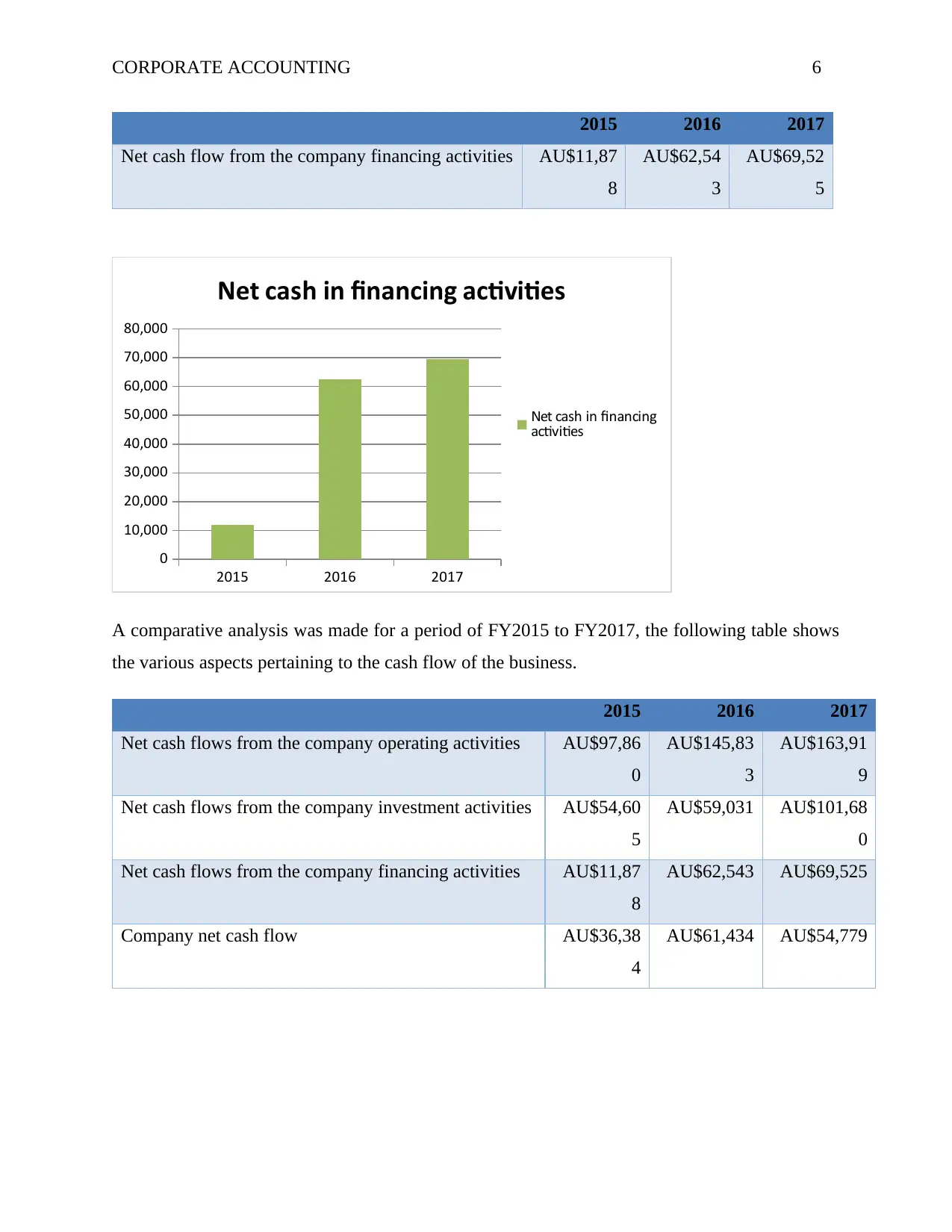
CORPORATE ACCOUNTING 6
2015 2016 2017
Net cash flow from the company financing activities AU$11,87
8
AU$62,54
3
AU$69,52
5
2015 2016 2017
0
10,000
20,000
30,000
40,000
50,000
60,000
70,000
80,000
Net cash in financing activities
Net cash in financing
activities
A comparative analysis was made for a period of FY2015 to FY2017, the following table shows
the various aspects pertaining to the cash flow of the business.
2015 2016 2017
Net cash flows from the company operating activities AU$97,86
0
AU$145,83
3
AU$163,91
9
Net cash flows from the company investment activities AU$54,60
5
AU$59,031 AU$101,68
0
Net cash flows from the company financing activities AU$11,87
8
AU$62,543 AU$69,525
Company net cash flow AU$36,38
4
AU$61,434 AU$54,779
2015 2016 2017
Net cash flow from the company financing activities AU$11,87
8
AU$62,54
3
AU$69,52
5
2015 2016 2017
0
10,000
20,000
30,000
40,000
50,000
60,000
70,000
80,000
Net cash in financing activities
Net cash in financing
activities
A comparative analysis was made for a period of FY2015 to FY2017, the following table shows
the various aspects pertaining to the cash flow of the business.
2015 2016 2017
Net cash flows from the company operating activities AU$97,86
0
AU$145,83
3
AU$163,91
9
Net cash flows from the company investment activities AU$54,60
5
AU$59,031 AU$101,68
0
Net cash flows from the company financing activities AU$11,87
8
AU$62,543 AU$69,525
Company net cash flow AU$36,38
4
AU$61,434 AU$54,779
⊘ This is a preview!⊘
Do you want full access?
Subscribe today to unlock all pages.

Trusted by 1+ million students worldwide
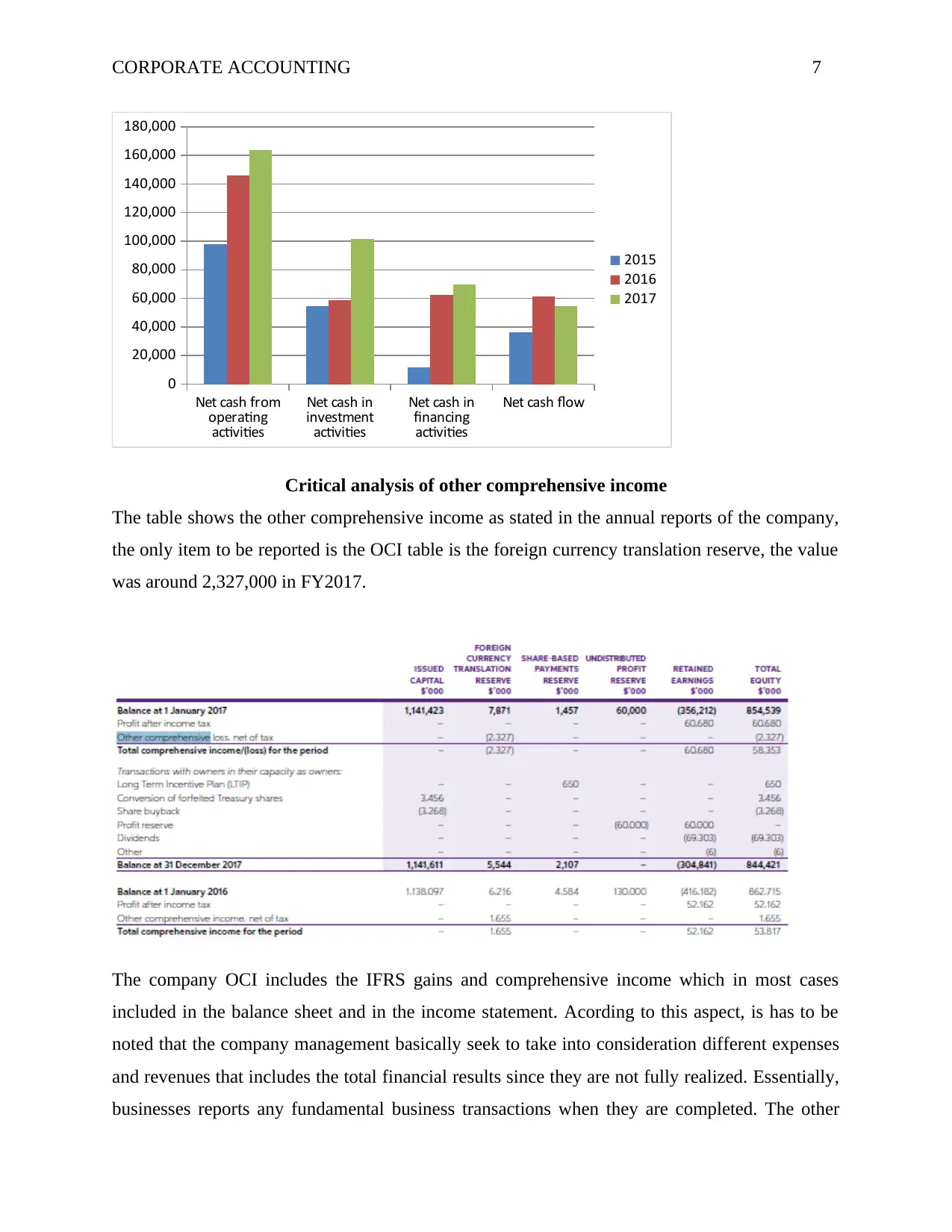
CORPORATE ACCOUNTING 7
Net cash from
operating
activities
Net cash in
investment
activities
Net cash in
financing
activities
Net cash flow
0
20,000
40,000
60,000
80,000
100,000
120,000
140,000
160,000
180,000
2015
2016
2017
Critical analysis of other comprehensive income
The table shows the other comprehensive income as stated in the annual reports of the company,
the only item to be reported is the OCI table is the foreign currency translation reserve, the value
was around 2,327,000 in FY2017.
The company OCI includes the IFRS gains and comprehensive income which in most cases
included in the balance sheet and in the income statement. Acording to this aspect, is has to be
noted that the company management basically seek to take into consideration different expenses
and revenues that includes the total financial results since they are not fully realized. Essentially,
businesses reports any fundamental business transactions when they are completed. The other
Net cash from
operating
activities
Net cash in
investment
activities
Net cash in
financing
activities
Net cash flow
0
20,000
40,000
60,000
80,000
100,000
120,000
140,000
160,000
180,000
2015
2016
2017
Critical analysis of other comprehensive income
The table shows the other comprehensive income as stated in the annual reports of the company,
the only item to be reported is the OCI table is the foreign currency translation reserve, the value
was around 2,327,000 in FY2017.
The company OCI includes the IFRS gains and comprehensive income which in most cases
included in the balance sheet and in the income statement. Acording to this aspect, is has to be
noted that the company management basically seek to take into consideration different expenses
and revenues that includes the total financial results since they are not fully realized. Essentially,
businesses reports any fundamental business transactions when they are completed. The other
Paraphrase This Document
Need a fresh take? Get an instant paraphrase of this document with our AI Paraphraser
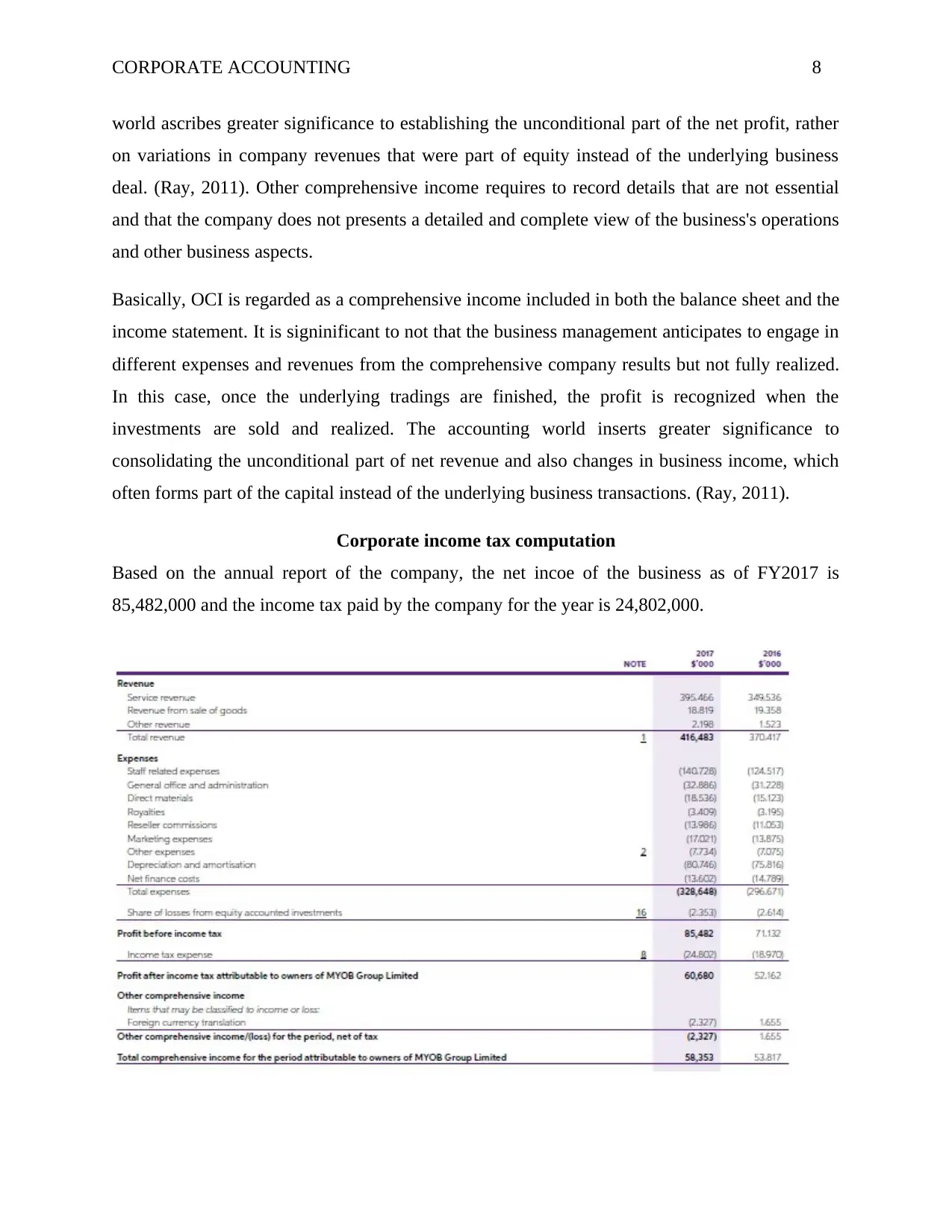
CORPORATE ACCOUNTING 8
world ascribes greater significance to establishing the unconditional part of the net profit, rather
on variations in company revenues that were part of equity instead of the underlying business
deal. (Ray, 2011). Other comprehensive income requires to record details that are not essential
and that the company does not presents a detailed and complete view of the business's operations
and other business aspects.
Basically, OCI is regarded as a comprehensive income included in both the balance sheet and the
income statement. It is signinificant to not that the business management anticipates to engage in
different expenses and revenues from the comprehensive company results but not fully realized.
In this case, once the underlying tradings are finished, the profit is recognized when the
investments are sold and realized. The accounting world inserts greater significance to
consolidating the unconditional part of net revenue and also changes in business income, which
often forms part of the capital instead of the underlying business transactions. (Ray, 2011).
Corporate income tax computation
Based on the annual report of the company, the net incoe of the business as of FY2017 is
85,482,000 and the income tax paid by the company for the year is 24,802,000.
world ascribes greater significance to establishing the unconditional part of the net profit, rather
on variations in company revenues that were part of equity instead of the underlying business
deal. (Ray, 2011). Other comprehensive income requires to record details that are not essential
and that the company does not presents a detailed and complete view of the business's operations
and other business aspects.
Basically, OCI is regarded as a comprehensive income included in both the balance sheet and the
income statement. It is signinificant to not that the business management anticipates to engage in
different expenses and revenues from the comprehensive company results but not fully realized.
In this case, once the underlying tradings are finished, the profit is recognized when the
investments are sold and realized. The accounting world inserts greater significance to
consolidating the unconditional part of net revenue and also changes in business income, which
often forms part of the capital instead of the underlying business transactions. (Ray, 2011).
Corporate income tax computation
Based on the annual report of the company, the net incoe of the business as of FY2017 is
85,482,000 and the income tax paid by the company for the year is 24,802,000.
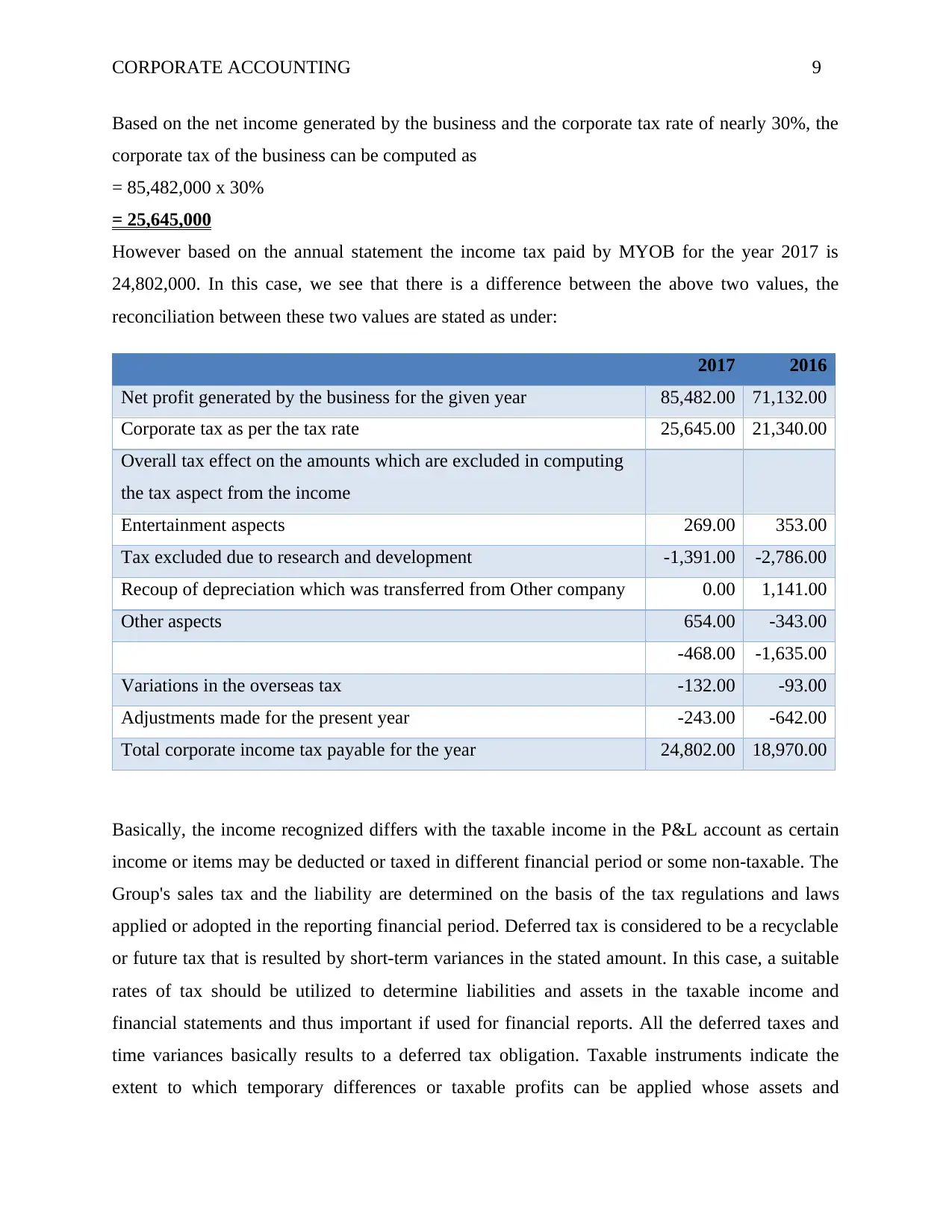
CORPORATE ACCOUNTING 9
Based on the net income generated by the business and the corporate tax rate of nearly 30%, the
corporate tax of the business can be computed as
= 85,482,000 x 30%
= 25,645,000
However based on the annual statement the income tax paid by MYOB for the year 2017 is
24,802,000. In this case, we see that there is a difference between the above two values, the
reconciliation between these two values are stated as under:
2017 2016
Net profit generated by the business for the given year 85,482.00 71,132.00
Corporate tax as per the tax rate 25,645.00 21,340.00
Overall tax effect on the amounts which are excluded in computing
the tax aspect from the income
Entertainment aspects 269.00 353.00
Tax excluded due to research and development -1,391.00 -2,786.00
Recoup of depreciation which was transferred from Other company 0.00 1,141.00
Other aspects 654.00 -343.00
-468.00 -1,635.00
Variations in the overseas tax -132.00 -93.00
Adjustments made for the present year -243.00 -642.00
Total corporate income tax payable for the year 24,802.00 18,970.00
Basically, the income recognized differs with the taxable income in the P&L account as certain
income or items may be deducted or taxed in different financial period or some non-taxable. The
Group's sales tax and the liability are determined on the basis of the tax regulations and laws
applied or adopted in the reporting financial period. Deferred tax is considered to be a recyclable
or future tax that is resulted by short-term variances in the stated amount. In this case, a suitable
rates of tax should be utilized to determine liabilities and assets in the taxable income and
financial statements and thus important if used for financial reports. All the deferred taxes and
time variances basically results to a deferred tax obligation. Taxable instruments indicate the
extent to which temporary differences or taxable profits can be applied whose assets and
Based on the net income generated by the business and the corporate tax rate of nearly 30%, the
corporate tax of the business can be computed as
= 85,482,000 x 30%
= 25,645,000
However based on the annual statement the income tax paid by MYOB for the year 2017 is
24,802,000. In this case, we see that there is a difference between the above two values, the
reconciliation between these two values are stated as under:
2017 2016
Net profit generated by the business for the given year 85,482.00 71,132.00
Corporate tax as per the tax rate 25,645.00 21,340.00
Overall tax effect on the amounts which are excluded in computing
the tax aspect from the income
Entertainment aspects 269.00 353.00
Tax excluded due to research and development -1,391.00 -2,786.00
Recoup of depreciation which was transferred from Other company 0.00 1,141.00
Other aspects 654.00 -343.00
-468.00 -1,635.00
Variations in the overseas tax -132.00 -93.00
Adjustments made for the present year -243.00 -642.00
Total corporate income tax payable for the year 24,802.00 18,970.00
Basically, the income recognized differs with the taxable income in the P&L account as certain
income or items may be deducted or taxed in different financial period or some non-taxable. The
Group's sales tax and the liability are determined on the basis of the tax regulations and laws
applied or adopted in the reporting financial period. Deferred tax is considered to be a recyclable
or future tax that is resulted by short-term variances in the stated amount. In this case, a suitable
rates of tax should be utilized to determine liabilities and assets in the taxable income and
financial statements and thus important if used for financial reports. All the deferred taxes and
time variances basically results to a deferred tax obligation. Taxable instruments indicate the
extent to which temporary differences or taxable profits can be applied whose assets and
⊘ This is a preview!⊘
Do you want full access?
Subscribe today to unlock all pages.

Trusted by 1+ million students worldwide
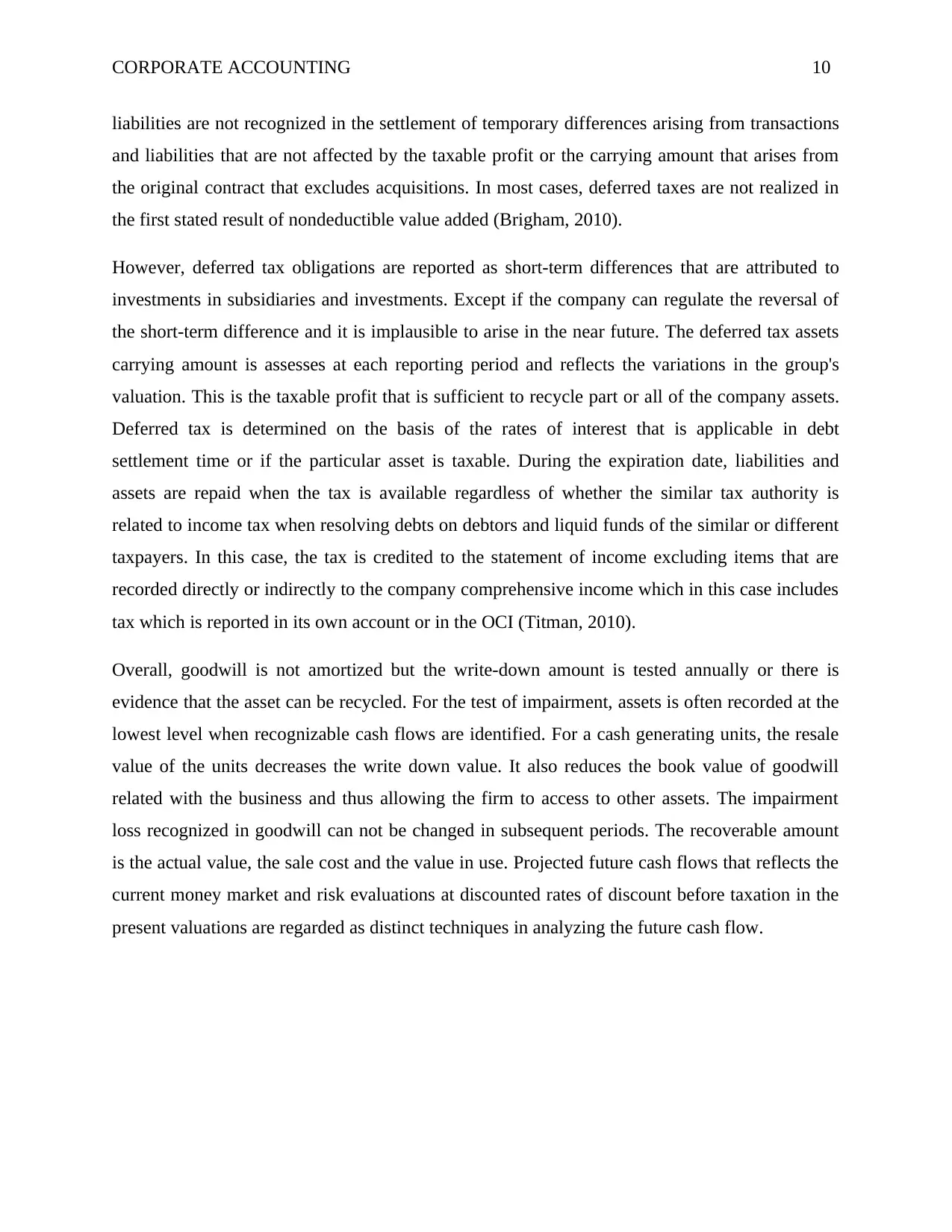
CORPORATE ACCOUNTING 10
liabilities are not recognized in the settlement of temporary differences arising from transactions
and liabilities that are not affected by the taxable profit or the carrying amount that arises from
the original contract that excludes acquisitions. In most cases, deferred taxes are not realized in
the first stated result of nondeductible value added (Brigham, 2010).
However, deferred tax obligations are reported as short-term differences that are attributed to
investments in subsidiaries and investments. Except if the company can regulate the reversal of
the short-term difference and it is implausible to arise in the near future. The deferred tax assets
carrying amount is assesses at each reporting period and reflects the variations in the group's
valuation. This is the taxable profit that is sufficient to recycle part or all of the company assets.
Deferred tax is determined on the basis of the rates of interest that is applicable in debt
settlement time or if the particular asset is taxable. During the expiration date, liabilities and
assets are repaid when the tax is available regardless of whether the similar tax authority is
related to income tax when resolving debts on debtors and liquid funds of the similar or different
taxpayers. In this case, the tax is credited to the statement of income excluding items that are
recorded directly or indirectly to the company comprehensive income which in this case includes
tax which is reported in its own account or in the OCI (Titman, 2010).
Overall, goodwill is not amortized but the write-down amount is tested annually or there is
evidence that the asset can be recycled. For the test of impairment, assets is often recorded at the
lowest level when recognizable cash flows are identified. For a cash generating units, the resale
value of the units decreases the write down value. It also reduces the book value of goodwill
related with the business and thus allowing the firm to access to other assets. The impairment
loss recognized in goodwill can not be changed in subsequent periods. The recoverable amount
is the actual value, the sale cost and the value in use. Projected future cash flows that reflects the
current money market and risk evaluations at discounted rates of discount before taxation in the
present valuations are regarded as distinct techniques in analyzing the future cash flow.
liabilities are not recognized in the settlement of temporary differences arising from transactions
and liabilities that are not affected by the taxable profit or the carrying amount that arises from
the original contract that excludes acquisitions. In most cases, deferred taxes are not realized in
the first stated result of nondeductible value added (Brigham, 2010).
However, deferred tax obligations are reported as short-term differences that are attributed to
investments in subsidiaries and investments. Except if the company can regulate the reversal of
the short-term difference and it is implausible to arise in the near future. The deferred tax assets
carrying amount is assesses at each reporting period and reflects the variations in the group's
valuation. This is the taxable profit that is sufficient to recycle part or all of the company assets.
Deferred tax is determined on the basis of the rates of interest that is applicable in debt
settlement time or if the particular asset is taxable. During the expiration date, liabilities and
assets are repaid when the tax is available regardless of whether the similar tax authority is
related to income tax when resolving debts on debtors and liquid funds of the similar or different
taxpayers. In this case, the tax is credited to the statement of income excluding items that are
recorded directly or indirectly to the company comprehensive income which in this case includes
tax which is reported in its own account or in the OCI (Titman, 2010).
Overall, goodwill is not amortized but the write-down amount is tested annually or there is
evidence that the asset can be recycled. For the test of impairment, assets is often recorded at the
lowest level when recognizable cash flows are identified. For a cash generating units, the resale
value of the units decreases the write down value. It also reduces the book value of goodwill
related with the business and thus allowing the firm to access to other assets. The impairment
loss recognized in goodwill can not be changed in subsequent periods. The recoverable amount
is the actual value, the sale cost and the value in use. Projected future cash flows that reflects the
current money market and risk evaluations at discounted rates of discount before taxation in the
present valuations are regarded as distinct techniques in analyzing the future cash flow.
Paraphrase This Document
Need a fresh take? Get an instant paraphrase of this document with our AI Paraphraser
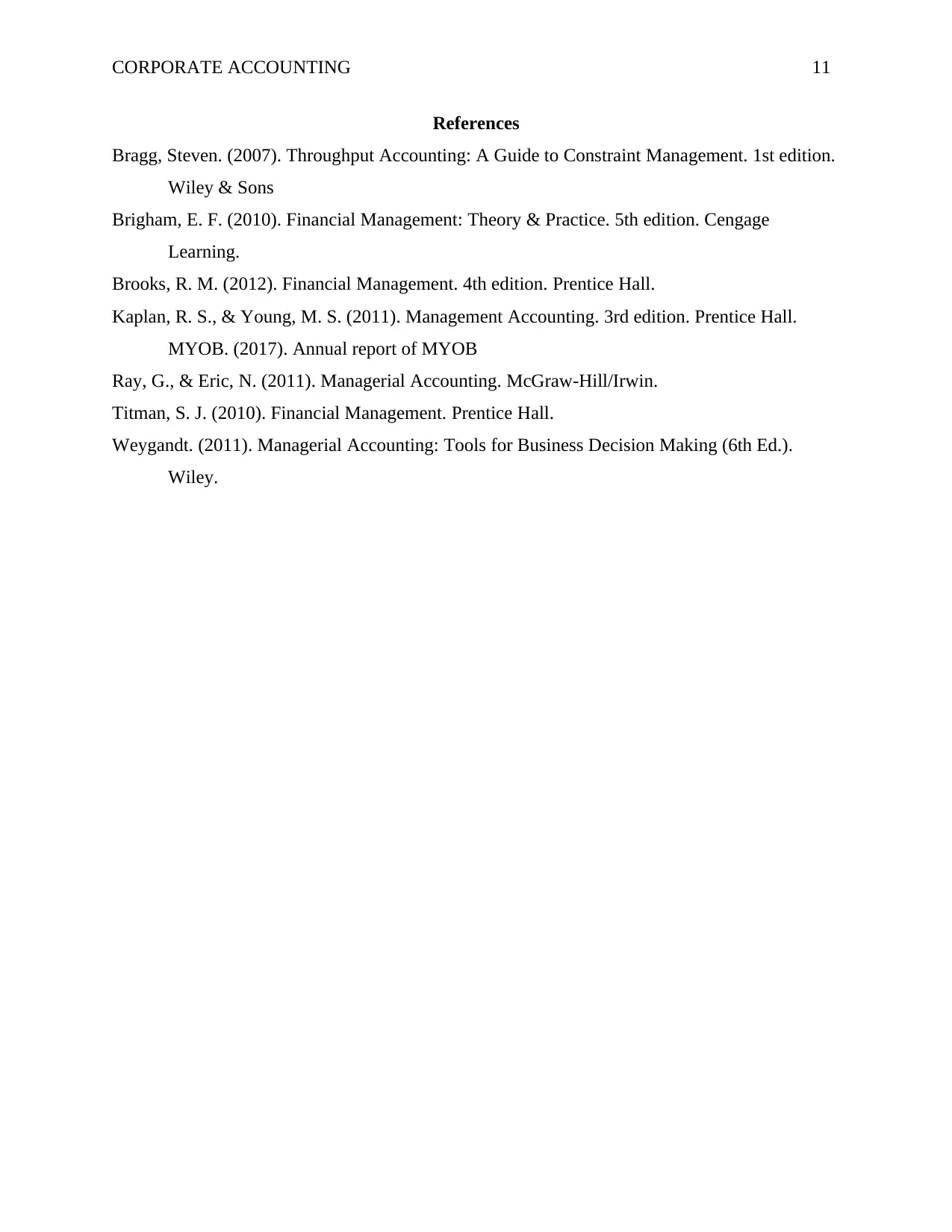
CORPORATE ACCOUNTING 11
References
Bragg, Steven. (2007). Throughput Accounting: A Guide to Constraint Management. 1st edition.
Wiley & Sons
Brigham, E. F. (2010). Financial Management: Theory & Practice. 5th edition. Cengage
Learning.
Brooks, R. M. (2012). Financial Management. 4th edition. Prentice Hall.
Kaplan, R. S., & Young, M. S. (2011). Management Accounting. 3rd edition. Prentice Hall.
MYOB. (2017). Annual report of MYOB
Ray, G., & Eric, N. (2011). Managerial Accounting. McGraw-Hill/Irwin.
Titman, S. J. (2010). Financial Management. Prentice Hall.
Weygandt. (2011). Managerial Accounting: Tools for Business Decision Making (6th Ed.).
Wiley.
References
Bragg, Steven. (2007). Throughput Accounting: A Guide to Constraint Management. 1st edition.
Wiley & Sons
Brigham, E. F. (2010). Financial Management: Theory & Practice. 5th edition. Cengage
Learning.
Brooks, R. M. (2012). Financial Management. 4th edition. Prentice Hall.
Kaplan, R. S., & Young, M. S. (2011). Management Accounting. 3rd edition. Prentice Hall.
MYOB. (2017). Annual report of MYOB
Ray, G., & Eric, N. (2011). Managerial Accounting. McGraw-Hill/Irwin.
Titman, S. J. (2010). Financial Management. Prentice Hall.
Weygandt. (2011). Managerial Accounting: Tools for Business Decision Making (6th Ed.).
Wiley.
1 out of 11
Related Documents
Your All-in-One AI-Powered Toolkit for Academic Success.
+13062052269
info@desklib.com
Available 24*7 on WhatsApp / Email
![[object Object]](/_next/static/media/star-bottom.7253800d.svg)
Unlock your academic potential
Copyright © 2020–2025 A2Z Services. All Rights Reserved. Developed and managed by ZUCOL.





